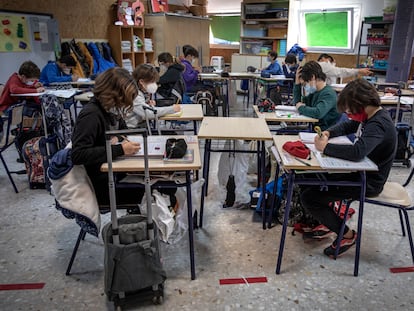Spain records drop in hospital admissions as coronavirus cases fall
Pressure in intensive care units, however, continues to rise, with 20.8% of beds occupied by Covid-19 patients

The number of coronavirus cases in Spain’s fifth wave has been on a downward trend since July 28, but it is only now that the fall is being reflected in hospital admissions for Covid-19. For the first time since June, the number of weekly hospitalizations has fallen: on Monday, 10,411 people were in hospital with Covid-19, 167 fewer than seven days ago. While this figure is higher than what was reported on Friday (10,015), this is because the data reported on Mondays cover the weekends, and fewer patients are discharged on Saturdays and Sundays.
It’s an emerging trend, but one that follows the pattern seen throughout the pandemic: first cases fall, then hospitalization, followed by intensive care unit (ICU) admissions and finally the number of fatalities. These last two statistics are, however, continuing to rise. On Monday, 2,031 people were in ICU with Covid-19, 175 more than the previous week. This means that 20.8% of all ICU beds and emergency resources are occupied by Covid-19 patients – a figure that indicates a situation of “high risk,” according to the Spanish Health Ministry’s traffic light system. Meanwhile, the national incidence rate continues to fall. According to the latest Health Ministry report, released Monday evening, the 14-day cumulative number of cases per 100,000 inhabitants has fallen to 549, down from 591 last Monday. This indicates that the rest of the indicators, i.e. the number of ICU admissions and fatalities, will start to fall in the next few days.
The Covid-19 vaccination drive has also changed the profile of Covid-19 patients. Unlike previous waves which affected the over-80s, 60% of patients in the fifth wave are under the age of 60, according to provisional data from the Carlos III Health Institute (which need between two to three weeks to be consolidated). Indeed, this data indicates that most Covid-19 patients are in their thirties. The virus has been spreading quickly among the 30-39 population, most of whom were not vaccinated when the fifth wave hit in June. The second-highest number of hospital admissions is among the 60-69 age group. Although there have been fewer cases in this bracket, it is the one that is more vulnerable to the virus. When the fifth wave began, half of the 60-69s were still waiting for their second shot of the Oxford-AstraZeneca vaccine, which has a much longer interval than other vaccines.
In previous waves, hospital admissions increased by age in ascending order, with the 10-30 age group making up only 16% of all hospitalizations. Now there is no clear pattern: hospitalizations increase among different age groups depending on a demographic’s specific transmission rate, vaccination coverage and vulnerability to the virus.
Madrid’s Gregorio Marañón Hospital is starting to see a fall in admissions as the fifth wave eases. But Sonia García San José, the deputy manager of the hospital, says this is not yet being reflected in the ICUs. “Although we have needed to completely suspend non-urgent surgical activity, as happened in other waves, we have had to adapt in order to use [non-structural] beds. We are attending to scheduled appointments fundamental to oncology and priority patients,” she said.
According to García San Sol, patients in her hospital are generally younger than in previous waves. The health worker is also worried about pregnant women and women who have recently given birth and are not immunized, who are not one of the groups most vulnerable to the virus. “We are calling them to get vaccinated as soon as possible,” she said.
English version by Melissa Kitson.
Tu suscripción se está usando en otro dispositivo
¿Quieres añadir otro usuario a tu suscripción?
Si continúas leyendo en este dispositivo, no se podrá leer en el otro.
FlechaTu suscripción se está usando en otro dispositivo y solo puedes acceder a EL PAÍS desde un dispositivo a la vez.
Si quieres compartir tu cuenta, cambia tu suscripción a la modalidad Premium, así podrás añadir otro usuario. Cada uno accederá con su propia cuenta de email, lo que os permitirá personalizar vuestra experiencia en EL PAÍS.
¿Tienes una suscripción de empresa? Accede aquí para contratar más cuentas.
En el caso de no saber quién está usando tu cuenta, te recomendamos cambiar tu contraseña aquí.
Si decides continuar compartiendo tu cuenta, este mensaje se mostrará en tu dispositivo y en el de la otra persona que está usando tu cuenta de forma indefinida, afectando a tu experiencia de lectura. Puedes consultar aquí los términos y condiciones de la suscripción digital.
More information
Últimas noticias
Most viewed
- Reinhard Genzel, Nobel laureate in physics: ‘One-minute videos will never give you the truth’
- Oona Chaplin: ‘I told James Cameron that I was living in a treehouse and starting a permaculture project with a friend’
- Pablo Escobar’s hippos: A serious environmental problem, 40 years on
- Chevy Chase, the beloved comedian who was a monster off camera: ‘Not everyone hated him, just the people who’ve worked with him’
- Why we lost the habit of sleeping in two segments and how that changed our sense of time











































